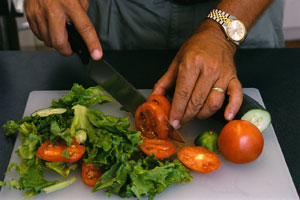|
Lesson
1 – Favorite Foods
Preparation:
Prior to Lesson 1, assign students to keep a
record of what they eat for three days using the
Eating Habits worksheet.
Time frame:
Two 60-minute class periods; Follow up with one 20-minute Healthy
Goals check-up discussion every other week.
Lesson Goal:
Students will demonstrate the ability to develop and implement goals
for healthful eating habits.
Objectives:
Students will identify influences that affect what we eat.
Materials:
Eating Habits worksheets
Food and Mood Cartoons and Verse
http://www.foodandmood.org/Pages/poem.html
Used with permission.
Teens Health: The Food
Guide Pyramid
http://www.kidshealth.org/teen/food_fitness/nutrition/pyramid.html
Procedure:
I.
Introduction
a. When the teacher says the word
"food," have each student in the class name the first food that
comes to his/her mind that has not been previously named by other class
members. As each food is named, the students should write the food on a
sheet of paper.
b. The students should circle the foods they like.
c. The teacher will facilitate a large group discussion of the reasons
students like or dislike a particular food. Have students write down
reasons for liking or disliking each food.
d. Discuss the many factors that influence food choices. Each individual
has different reasons for liking or disliking a food, no two people are
the same.
II.
Discussion
Discuss the following questions and
let the students respond:
a. Do you eat when you are not hungry?
b. At your house, where do you most often eat?
c. Do you watch television and eat at the same time?
d. With whom do you most often eat?
e. At which meal do you usually eat the most?
f. Who skipped breakfast this morning?
III.
Influences
Explain that there are many
influences that affect what we eat, and let students brainstorm those
influences. examples
§
hunger or appetite
§
nutritional requirements
§
the need for energy
§
our attitude towards a food
§
our emotions
§
the smell, color, texture, temperature, and shape of foods
§
fond memories associated with foods
§
availability of food
§
advertising associated with foods
§
society and cultural rituals associated with food
IV.
Eating Habits
Discuss the findings of their Eating
Habits worksheets.
a. How many foods were eaten because of an emotional influence (sad,
upset, bored, or anxious?)
b. How many times were foods eaten "on the go" (in the car, fast
food, out of cartons, etc.)?
c. How often was hunger associated with eating?
d. When hunger was associated with eating, what types of foods were chosen
to eat?
e. What types of food were eaten away from home?
f. How often was food eaten just because someone else was eating?
g. Where and when were foods eaten that were not healthy choices?
h. When watching television, what and how much food was eaten?
i. Are present eating habits affecting your personal health and
well-being?
j. What changes need to be made in your personal eating habits?
V. Food Mood
Read the Food and Mood Poem as a class and discuss.
Food Mood cartoons and verse
http://www.foodandmood.org/Pages/poem.html
VI. Meeting the Food
Pyramid
Provide students with the resources that explore the Food Pyramid so that
they can begin to familiarize themselves with the concept.
Teens Health: The Food Guide Pyramid
http://www.kidshealth.org/teen/food_fitness/nutrition/pyramid.html
VII.
Goal Setting
Have students select a goal to
improve their current eating habits. Goals could include: eating less
fats, eating fruits instead of candy, eating only at the table, etc. Goals
should follow these guide lines:
a. The goal should promote good health.
b. Select a simple goal that can actually be attained and measured.
c. Goals should be written down in detail.
d. Goal reminders should be placed in areas where the student practices
inappropriate eating habits.
e. Encourage choices of non-food rewards such as a movie, CD, etc.
 VI.
Extension Activity VI.
Extension Activity
Obtain five pots of the same type of
plant. Treat the plants as explained below then relate it to nutrition:
a. Do not water one plant (withholding minerals)
b. Keep one plant out of the sunlight (withholding vitamins)
c. Over-water or over-fertilize one plant (overeating)
d. Place one plant in shallow dirt (no exercise)
e. Maintain one healthy plant (a body that is well cared for--proper
nutrition and exercise).
Assessment:
In small groups and as a class, review personal progress and
accomplishments monthly as related to the students' written Healthy Goals.
|

